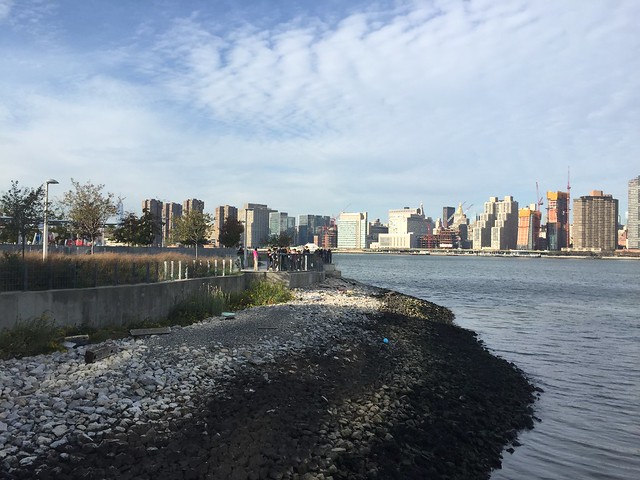FOR IMMEDIATE RELEASE 15-88 October 20, 2015 Contact: deppressoffice@dep.nyc.gov, (718) 595-6600 New York City Public School Students Study the Ecological Health of the East River as Part of “A Day in the Life: Hudson River Estuary Snapshot” EventStudents Gather at Gantry Plaza State Park in Queens to Collect Water Samples and Document the Health of the East RiverStatewide, Nearly 5,000 Students at 75 Locations, From Troy to New York City, Explore and Learn About the Hudson River EstuaryPhotos of the Event are Available on DEP’s Flickr PageThe New York City Department of Environmental Protection (DEP) today sponsored more than 50 public school students who participated in the New York State Department of Environmental Conservation’s (DEC) a “Day in the Life: Hudson River Snapshot” educational event. The students, 11th graders from Baruch College Campus High School in Manhattan and 7th graders from Hunter’s Point Community Middle School in Queens, participated in the event during which teams collected and analyzed water samples and made environmental observations along the East River, at Gantry Plaza State Park. Students used field techniques to track the river’s tides and currents, examined the water’s chemistry and identified macroinvertebrates and fish. This annual event is part of DEC’s Hudson River Estuary Program, which is sponsored by the Lamont-Doherty Earth Observatory of Columbia University. Now in its 13th year, the program helps prepare students to become stewards of the Hudson River Estuary’s natural resources. Statewide, nearly 5,000 students at 75 different locations, from Troy to New York City, participate in the hands-on scientific exploration of the Hudson River Estuary. “New York/New Jersey Harbor is a critical part of the productive Hudson River estuary and serves the largest population center in the United States,” said DEP Commissioner Emily Lloyd. “Over the last decade we have invested more than $10 billion to improve water quality and restore wetlands and adjacent grasslands which has helped to bring back native fish populations and allow for greater recreational use. This event educates thousands of young New Yorkers about the progress and challenges in protecting our natural resources and will create the stewards who will ensure that future generations can enjoy all the Hudson River Estuary has to offer.” “We are pleased NYC is participating in this Hudson Valley wide event, organized by DEC’s Hudson River Estuary program,” said Department of Environmental Conservation Acting Commissioner Marc Gerstman. “This annual event gives students a unique firsthand experience to learn about the Hudson River’s communities, watershed and ecosystem. This opportunity to be “scientists for a day” will give our young stewards a better appreciation of the Hudson River and the countless environmental benefits it offers to our state. During the event in Gantry Plaza State Park, five stations were set up where the students were able to measure the river’s currents and perform tests to determine the level of turbidity, pH, salinity and dissolved oxygen in the water. The high school students were paired with seventh graders and taught them how to properly measure water quality. The seventh graders taught their high school partners the techniques they use to clean and monitor the oysters they are raising in the East River. The students were supervised by science teachers from their schools and DEP staff. DEP supplied the equipment for the event, including seine nets and lab materials to investigate aquatic life, water chemistry and quality, tides and weather. The data collected by the nearly 5,000 students will be analyzed and posted on the “Day in the Life: Hudson River Snapshot” website. The Hudson River is not just a river – it is a tidal estuary. The estuary makes up the lower half of the Hudson River, spanning 153 miles from the tip of the Battery to the Troy Dam. The river experiences dramatic changes in salinity, circulation patterns, tidal ranges, river width and water depth, fish species, macro invertebrate communities, and plant life. While the northern half of the river is freshwater fed by snowmelt, groundwater and rain, the southern estuary section is a tidal mix of salty seawater and freshwater. DEP manages New York City’s water supply, providing more than one billion gallons of water each day to more than 9 million residents, including 8.4 million in New York City. The water is delivered from a watershed that extends more than 125 miles from the city, comprising 19 reservoirs and three controlled lakes. Approximately 7,000 miles of water mains, tunnels and aqueducts bring water to homes and businesses throughout the five boroughs, and 7,500 miles of sewer lines and 96 pump stations take wastewater to 14 in-city treatment plants. DEP has nearly 6,000 employees, including almost 1,000 in the upstate watershed. In addition, DEP has a robust capital program, with nearly $14 billion in investments planned over the next 10 years that will create up to 3,000 construction-related jobs per year. This capital program is responsible for critical projects like City Water Tunnel No. 3; the Staten Island Bluebelt program, an ecologically sound and cost-effective stormwater management system; the city’s Watershed Protection Program, which protects sensitive lands upstate near the city’s reservoirs in order to maintain their high water quality; and the installation of more than 820,000 Automated Meter Reading devices, which allow customers to track their daily water use, more easily manage their accounts, and be alerted to potential leaks on their properties. For more information, visit nyc.gov/dep, like us on Facebook, or follow us on Twitter. | ||
